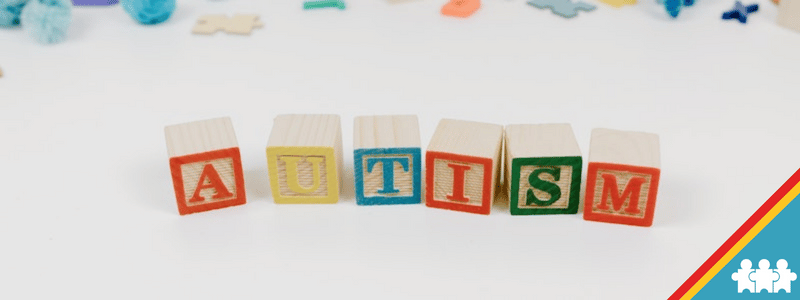What is ABA Therapy?
In our Guide to ABA Therapy, we will get you up to speed on what Applied Behavior Analysis Therapy is, why it works, and how our integrated approach can be beneficial for your child’s development in therapy for autism.
What is ABA Therapy?
ABA stands for Applied Behavior Analysis.
ABA therapy is an evidence-based treatment that focuses on improving behaviors critical to your child and family by teaching new skills to help your child reach their maximum potential.
ABA therapy targets challenging behaviors that may be getting in the way of your child’s development and improve those areas. Ultimately, we want to increase desired behaviors and decrease challenging or undesired behaviors. This is all done in a safe, ethical manner backed by decades of thorough research.
Whether you realize it or not, you and everyone around you use the basic science of ABA. We are all connected to and influenced by our environment. It shapes our behavior through our positive and negative experiences and reactions.
What Are the Benefits of Applied Behavior Analysis Therapy?
Along with the well-documented benefits of ABA therapy, we have improved upon and adapted different strategies of ABA to increase the success of its methods.
For parents, being familiar with the strategies and techniques of ABA allows you to feel confident in teaching your children new skills, allowing you to be more involved in their development. As a parent, it will increase your confidence, decrease stress, and lessen obstacles to your child’s healthy development.
As you play this vital role in your child’s development, you’ll begin handling problem behaviors from your child more effectively. This opens up more avenues to integrate your child into different environments.

For example, if your child tends to display problem behaviors in crowds or out in the community, recognizing the precursor behaviors and how to de-escalate those behaviors will help you better ease your child into these situations.
Further along in this guide, we will discuss more specifics on different types of ABA therapeutic teaching strategies. By being familiar with these ABA practices that your child’s technicians or Registered Behavior Technicians (RBTs) are using within sessions, you can take those same principles and bring them into your home environment.
As a parent, the biggest takeaway is that your child’s learning will become more interactive, fun, and engaging. You will be right in the thick of things with the ABA therapists to see your child’s improvements.
Using reinforcement gives you a way to naturally teach your child that certain behaviors will be less “valuable” to them, meaning they don’t gain access to what they want if they exhibit that specific behavior. On the other hand, certain behaviors will become more “valuable,” meaning they will gain access to those reinforcing items based on appropriate or positive behaviors.
| ABA Therapy Success Rates |
|---|
| A 1987 study found that 90% of autistic clients showed behavioral improvements after ABA interventions. |
| In 2005, 48% of autistic children succeeded in regular classrooms when introduced to ABA therapy at a young age. |
| ABA therapy accounts for 45% of therapies introduced to autistic children that have long-term success. |
| 50% of autistic children who receive ABA therapy before turning four years old show improved social and speaking skills, and their IQ levels rise. |
| According to Swallows and Graupner in 2005, 48% of clients on the spectrum made rapid progress in learning and test scores after receiving ABA therapy. |
Is ABA Therapy only for Autism?
In your research on ABA therapy, you’ve probably noticed that its primary use is to teach and assist in the development of autistic children. ABA is not just for autistic individuals but is also used to help with other disorders. ABA therapy’s behavioral interventions can help treat various cognitive and behavioral disorders.
The strength of ABA comes in its ability to reinforce positive human behaviors. It’s also easily adaptable to each individual, catering to their unique needs. There isn’t just one specific situation or diagnosis that benefits from ABA therapy.
At its core, ABA therapy uses techniques to assess, analyze, and treat any behavioral challenges. This pertains to all ages and levels of development as well. It’s the science of teaching and learning, and ABA therapy principles can help children and adults integrate into their environments.
What Does an ABA Therapist Do?
Ultimately, an ABA therapist is there to help your child with development and learning. But the therapist needs to make the environment positive, fun and reinforcing. To do this effectively, one of the first things an ABA therapist does with any child is a technique called pairing.
Pairing allows us to get to know your child, finding out what they enjoy and what they don’t enjoy. It enables the therapist to make the experience fun for your child and helps them discover what motivates your child and how strong that motivating factor is during the learning process.
Learn More: What does an ABA Therapist do?
The goal is to “pair” a learning objective, an action, or even the therapists themselves, with a reinforcing item or action. The pairing process is critical to creating that connection and trust between the therapist and your child. It’s common for a therapist to spend a good portion of the first few sessions just playing with your child. Knowing that therapy involves more than just completing tasks and objectives allows your child to be more comfortable and willing during a session.
Experienced therapists will use reinforcers like your child’s favorite toy or game to show that they are more than just an instructor. The therapist’s goal is to show they are an avenue for fun and that reinforcing items or actions are more enjoyable with the therapist involved rather than without them. If a therapist successfully creates this relationship, your child’s teaching is much easier.
Another way therapists use reinforcers is by expanding those interests into new items and activities. This is important because it creates more opportunities for your child to interact with peers. The more activities and toys your child enjoys means more connections they can make with those around them.
During a session, the therapist utilizes a comprehensive, individualized treatment plan to address your child’s specific needs. A team develops the program made up of one or more Board Certified Behavior Analysts (BCBAs).
Our team will base your child’s goal development on their assessment results. The BCBA will choose the goals that directly meet the challenges displayed in the assessment. This also includes a behavior intervention plan to address any challenging behaviors.
The ABA therapist will collect data throughout the session with your child. This data includes:
- Correct and incorrect responses during programs
- Frequency and duration of behaviors
- Instances of communication
- Prompts needed to complete the skill, among other things
Our team graphs this data, allowing the BCBA(s) to analyze your child’s progress or lack thereof. This readily available data allows for any changes if/when necessary to increase progress with your child.
Communication is key in ABA therapy. Therapists will regularly contact the BCBA overseeing the treatment plan to share any significant changes or needs during the session or the discovery of any new behaviors.
Likewise, communication comes into play when discussing sessions with you as the parent. An ABA therapist knows the importance of keeping you in the loop and will give you updates at the end of each session.
BCBA and ABA Therapist Statistics in the U.S.
| BCBA | ABA Therapist | |
| Average Age | 35-40 years old | 35-40 years old |
| Gender Ratio | F: 71.1%M: 28.9% | F: 85.60%M: 15.4% |
| Job Growth rate | More than 20% increase in the next eight years. | More than 20% increase by 2029. |
| Average Salary | $85,571 | $42,735 |
| Employed in the U.S. | Approximately 59,976 | Approximately 33,633 |
What is a Typical Session Structure of ABA Therapy?
Before each session, the therapist will have an idea of what ABA programs they will work on that day.
Each therapy session will typically start with the therapist going through a pairing phase with the child. This includes pairing themselves with reinforcers so the child sees them as a “giver of fun things.”

Also, the therapist needs to find out what the child will be motivated by during that particular session. Reinforcers can vary from session to session, so it’s important to identify them at the beginning of each session.
Another big part of this pairing process is demonstrating to the child that their session isn’t all about work with no play. Therapy should be fun for the child and the therapist; that’s when the most meaningful learning occurs. Trust develops during this time, and the child and the therapist develop a connection.
Learn More: ABA Basics for Parents: 6 Tips for Starting Therapy
During the session, the therapist will intertwine play with teaching moments. It’s essential to keep learning engaging for the child, so introducing moments of play and interaction is key to a successful session. Our team will work with your child several hours per week, practicing play and encouraging concepts like socialization and creativity.
A good therapist will always look for reasons to praise and give positive reinforcement to the child. Even if the child is having an off day, displaying more problem behaviors than usual, or just not fully grasping programs as well as they usually do, there are always small victories to celebrate.
These small victories can help get the learning momentum back on track and keep your child comfortable, happy, and motivated.
We also incorporate reinforcer leisure and break time between programs. However, even during these times, there are learning opportunities. Keeping the child engaged and interacting with those around them throughout the session is important, even during leisure time.
An example of this is when two children play together during a break. Maybe they both want access to the same toy. The therapist can take this opportunity to teach sharing or even collaborative play. This is also an excellent opportunity to work on social skills with peers.
How Long Does ABA Therapy Last?
How long your child’s ABA therapy lasts depends on several factors. Each child is different, so we can’t give a concrete timetable on how long treatment will take.
Some factors to consider include the following:
- The complexity and severity of your child’s problem behaviors
- The scope of skill difficulties
- The age of your child
- Your child’s learning history
- Parental involvement
In some cases, ABA therapy is a temporary intervention for your child’s development process. Other times, the child may need long-term therapy to ensure ongoing progress in certain areas and reduce the chance of regression. Again, this will depend on the specific child and situation.

However, it’s important to remember that your child will be progressing, even if the changes are more subtle. Because ABA has so much evidence pointing to its effectiveness, it’s essential to be patient and trust the process. Never be afraid to ask questions to understand your child’s development better.
Does Insurance Cover ABA Therapy?
Over the last decade, tremendous strides have brought awareness and development progress to ABA therapy. Because of this, over 200 million people have insurance coverage for ABA therapy, and all 50 states now mandate coverage for ABA. The details of your insurance plan will dictate what coverage you have.
We understand that it can be a stressful process to set in motion, and because of this, we will be there every step of the way.
Our team at Ally Pediatric Therapy will answer any questions you have and take some of that burden off your plate.
We want to help you set up coverage as quickly and seamlessly as possible so we can begin helping your child. Different plans cover ABA in various capacities, and we are happy to check to see what that looks like for your family.
ABA Techniques and Methods
Because ABA therapy is not a one-size fits all treatment plan, it means there need to be different ways of teaching based on the client. There is an abundance of different techniques and strategies we use within ABA therapy that can be tailored to the individual child.
While doing your research about ABA therapy, it’s likely that you’ve come across many different terms that you probably aren’t too familiar with. This can be frustrating as a parent, not knowing exactly how your child may be taught going forward. It’s natural to have questions as a parent being introduced to ABA therapy, which is why we want to provide you with this guide to help make the transition easier.
What are these ABA strategies I’ve read about? How do they work? What does this mean for my child’s therapy? What will my child’s day look like during therapy? Which one is right for my child?
The following will provide you with some answers to these questions and hopefully allow you to be more familiar with the teaching methods that will be used during your child’s development.
Natural Environment Teaching (NET)
Natural Environment Teaching, or NET, is one of the most commonly implemented principles of Applied Behavior Analysis (ABA). ABA is the gold standard for treatment of autistic children, and this is because NET and other naturalistic teaching strategies contribute to a framework that is designed for long-term behavioral development.
Incorporating natural environment teaching lesson plans can help your child’s therapist or clinician target specific impediments and allow your child to generalize across other environments. Because ABA therapy is so data-driven, the efficacy of these teaching techniques is traceable, while these metrics give credence to NET being extremely effective for treating certain behaviors. Read more to see how NET might be appropriate for your child’s ABA framework.
What Are Naturalistic Teaching Strategies?
NET is a tenet of ABA strategy, and it is all about naturalistic learning through play or education. This means that your child isn’t only learning in a clinic, with a therapist, or in a predetermined school curriculum; the goal is to apply ABA parameters across multiple environments and locations.
Because there are so many highly structured ABA principles, NET can act as a balance both for the way your child learns but also the way they feel about their exercises. After all, we don’t want therapy to seem like a chore, and getting into a more natural environment can make these exercises seem less like work for a child. Some tactics to achieve this include:
Progression-Based Reinforcement
Sometimes the behavioral chain in a real-life setting can be the best teacher. For example, if a child is hungry or thirsty and learns to ask correctly (using the correct term for a food, or including ‘please’), the reward can be that food or beverage.
Education in Natural Settings
Almost any environment can provide opportunities for teaching moments within a NET framework. Grocery stores, playgrounds, and restaurants all have unique challenges that can be related to specific skills. If these behaviors begin to appear across multiple environments, there is a better chance your child will grasp the generalization of them.
Teach While Your Child is Interested
It is human nature to devote more effort to a subject or situation that excites you. Thus, when your child is showing interest in something that you can use as a teaching moment, this is one of the best times to apply a NET behavioral strategy you are working with.
There are many other naturalistic teaching strategies encompassed in both ABA therapy and NET. The most important thing for you and your therapist to focus on is maintaining the ‘natural’ portion of any environment. To your child, playing or interacting with their peers is the main focus, and they will be able to generalize each lesson better if it occurs within an environmental flow.
Pivotal Response Treatment
Pivotal Response Treatment (PRT) is one of the core components of Applied Behavior Analysis (ABA) therapy. It is a play-based therapy technique initiated by your child, and the goal of PRT is to help improve behaviors in language, communication, and life skills. More importantly, PRT is able to target areas of behavioral development or ‘pivotal’ points, rather than focusing solely on individual behaviors.
In order to get your child the best autism treatment at the right clinic, having an understanding of the services offered is ideal. We will detail how PRT can and likely will be an integral strategy used by you, your therapist, and your child’s support group moving forward.
Evidence-Based Practice
The short and long-term results of PRT have been extremely positive; this is why the data-driven therapy approach to ABA has become the gold standard for modern autism treatment.
It is much easier to make decisions about specific treatment pathways for your child based on a framework designed by therapists who will track each behavior and adjust as need be. PRT plays right into this, as it works to help your child with their specific needs, rather than trying a one-size-fits-all approach.
The behaviors, exercises, and treatments that are implemented in PRT will typically include:
Natural environment-based treatments
These environments include home, school, and socializing with peers.
Family involvement
The more allies that your child has across each environment, the more teaching moments can be created.

Communication and Coordination
Your therapist or clinician should be providing the goals, exercises, and framework of a PRT treatment to anyone who is interested in helping your child change their behavior.
Specific Pivotal Areas
Your child and your family have unique environments and circumstances to deal with. As such, the pivotal areas and behaviors being worked on need to be specific to what everyday life looks like for you and your child.
Pivotal Response Treatment breaks down behaviors into micro-components that can be worked on in friendly environments, which increases your child’s chance of success. ABA therapy and PRT do a great job of showing you and your child’s therapist the logical next steps and the best ways to achieve behavioral change.
Discrete Trial Training
Discrete Trial Training (DTT) is adult directed instruction that uses mass trials and a chosen reinforcer to teach new skills. The formal steps in the DTT process are as follows:
- The behavior tech will deliver the instruction.
- The behavior tech will provide the appropriate prompt if/when necessary to assist your child in evoking the correct response.
- Your child will emit the response
- The behavior tech will deliver the chosen reinforcement for the correct response or corrective feedback for the incorrect response to your child.
- Intertrial interval ends one trial and signals that the next trail will be starting.
DTT uses arbitrary reinforcement and is often done at a table. This method is best for targeting discrete skills: skills that have a clear beginning and a clear end. Examples of discrete skills are: colors, letters, numbers, vehicles, etc.
Long-Lasting Results
In the field of ABA, we define maintenance as teaching skills so they will remain in your child’s repertoire, even after the teaching of that skill or behavior has ended. To achieve independence, we need to ensure your child is able to perform these skills or behaviors without prompting and have them occur naturally.
Generalization is one of the more important aspects in providing this meaningful learning. We want to make sure the results we get with your child are long-term results that will bleed into other skills, behaviors, environments, and with other people. This means making sure each behavior and skill is learned so that it’s carried over into environments other than where it was originally taught, as well as with other people outside of the therapist(s) who did the teaching. Achieving generalization is an indicator that the skill or behavior has been fully learned.
Prompting
Prompting isn’t necessarily a teaching method, however, it is used in all of the teaching methods listed above in one way or another. When first learning a skill, your child will obviously need some assistance. Prompts are ways to help your child learn and are a necessary avenue for independence.
It’s certainly possible that when first learning a new skill, your child will reach a correct response by continually making mistakes along the way. It would be more beneficial for your child to learn the most efficient way to a correct response, however.
When learning, allowing the child to continually make mistakes on the way to a correct response may increase the likelihood those mistakes remain. Afterall, they did eventually reach the desired behavior. But by prompting, we are teaching your child to get to that response with the least amount of resistance possible.

Like most things within ABA therapy, prompting comes in a variety of forms. It all depends on the skill being taught, how far along the child is with this skill, and how the individual child learns best. Some prompts are more intrusive while others allow for more independence. Some examples of prompting are:
- Physical prompts: Physically helping the child complete a task
- Gesture prompts: Using an observable gesture (pointing, nodding, etc.) towards a correct response
- Model or Visual prompts: A picture or cue given by the therapist that provides information about correct response
- Verbal prompts: Giving some sort of verbal cue towards the correct response
There are different variations of each of these prompts, some more intrusive than others. The prompts used will be chosen based on the program being taught and how the child learns best.
Eventually, the goal is to continually fade prompts until your child is independent with the skill or behavior. Some practices use a prompting hierarchy to fade prompts. In these cases, programs will start with the most intrusive prompt and, as criteria is met, the teaching will include less intrusive prompts until it’s mastered at full independence. This method is known as Most to Least prompting.
There are also programs that call for Least to Most prompting. This is where the therapist would start with either no prompting or the least intrusive prompt possible. More intrusive prompts would only be introduced with incorrect responses. This provides the child an opportunity to succeed with independence before corrections are given by the therapist.
Data-Based Decision Making
Regardless of the teaching method, ABA is a data driven form of treatment. It relies on research, as well as data recorded in real time, to produce the programs and methods that are effective for each individual client. The continuous influx of relevant information is what sets ABA apart from other teaching methods and makes it the most effective way of teaching our children.
Paying close attention to the details on a case by case basis ensures that the decisions we make on programming are best for that child. Each decision will be backed up by data and results, guesswork will never be in the equation. All members of the team working with a child will have access to data and each session will have data taken throughout its duration. The most up to date information will always be there for the team to make the most effective decisions. By doing so, we can adapt our methods as each child progresses throughout therapy.
Functions of Behavior in Applied Behavior Analysis
Three-Term Contingency for ABA Therapy
Three – Term Contingency is a foundational aspect of ABA Therapy. Many times referred to as the “ABCs of behavior,” it generally highlights how behavior is influenced by our environments, as well as how the consequences of these behaviors can shape its propensity for future occurrences.
The three-step process, or the “ABCs,” we are referring to are:
- Antecedent: events or actions that come BEFORE a behavior or response
- Behavior: resulting action from the antecedent
- Consequence: event or action that comes AFTER a behavior or response
Within our teaching environments, the RBT will be looking for a specific response or behavior from the child after delivering a specific opportunity. When the desired response or behavior occurs, a desirable reinforcer is presented for the child. This increases the likelihood that the response or behavior will occur again. The child will recognize that certain behaviors or responses will give them access to what they want.
Understanding the three-term contingency will also allow the supervising clinician to know why a challenging behavior is happening or determine its function. The BCBA will look at the consequence or what is maintaining the challenging behavior. How or why is your child getting what they “want” by engaging in challenging or undesired behavior?
ABA says there are four main functions of problem behavior. Your child will engage in the challenging behavior to either gain attention, escape or avoid a non-preferred task or situation, gain access to tangibles or something they desire, or have automatic reinforcement. Automatic reinforcement can be thought of as something that appeals to or offends the senses.
Published on August 8th, 2020
Updated on September 27th, 2022

